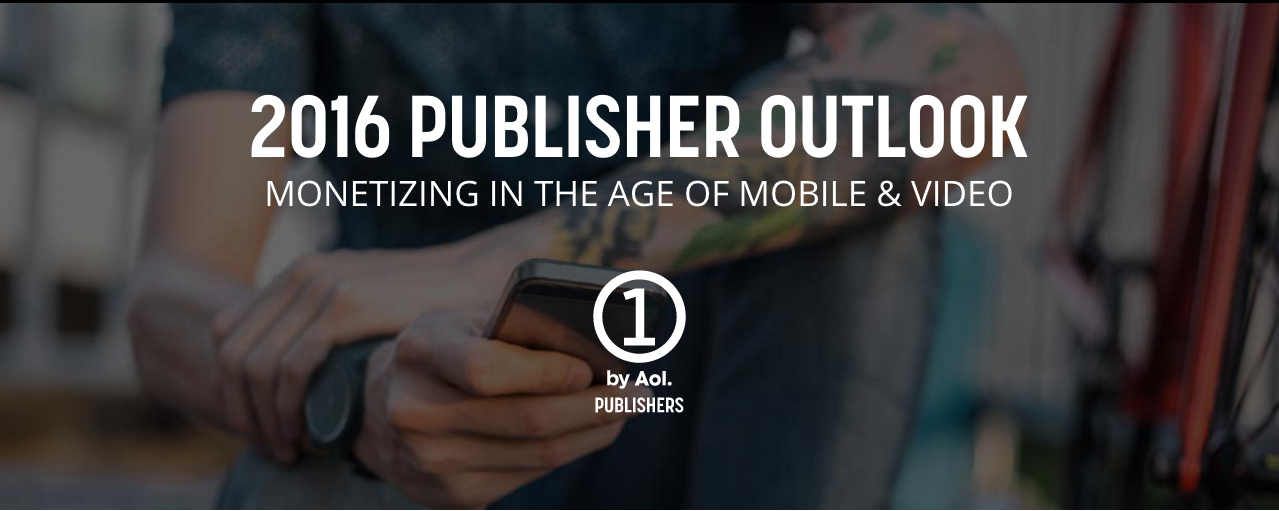A report released by AOL last week offers a glimpse into the future of mobile advertising — even if its findings must be taken with a grain of salt.
In a survey of about 300 publishers, AOL Platforms found that three-quarters of publishers plan to increase investment in mobile within the next 12 months; 49 percent see ad blockers as a major challenge to boosting mobile ad revenue; and 43 percent view better audience metrics as a primary advertising growth opportunity.
The report comes amid a trend of rapid growth in mobile content and advertising. According to Pew’s 2016 State of the News Media report, advertisers spent $31.6 billion on mobile advertising in 2015 — up from $19.2 billion a year earlier. And that number is only expected to grow as consumers spend more time tethered to their mobile devices, and as publishers improve and expand their mobile offerings.
The AOL report offers yet more evidence that publishers are scaling up their mobile presence — but its results do require a couple qualifiers: For one, AOL did not release a list of publishers included in the survey, making it difficult to generalize the results industry-wide. The study’s fine print noted only that 37 percent of respondents were strictly publishers; 53 percent were publishers and ad networks; and 10 percent were strictly ad networks. When asked to elaborate on the survey sample, Matt Gillis, senior vice president for publisher platforms at AOL Platforms, added that the survey covered a “big cross section” of publishers, including “heroes of the app economy” and “premium publishers that you would expect more in the online and display world.”
Another necessary asterisk is that AOL Platforms is not exactly neutral when it comes to mobile advertising. In fact, the report includes several invitations for users to learn more about AOL-based solutions to the problems or challenges raised by the survey. However, Gillis says that driving business wasn’t the purpose of the company’s report.
“Our goal was really to continue the track of thought leadership that we’ve led for so long in this business,” he said. “We hope that all boats rise when we share this data.”
Qualifiers aside, the study did include several insights that could have major implications for publishers and advertisers alike. Here’s a closer look at three of the key findings that relate to mobile advertising.
Mobile Publishing Is Poised to Keep Growing
According to the survey, 73 percent of publishers have increased their mobile inventory in the last 12 months, and 75 percent expect to increase mobile investment in the next year. Gillis says that while these numbers reflect the likelihood of continued mobile growth, he’s surprised that the projected mobile investment wasn’t even higher.
“Just walk down the street and try to find someone who’s not buried in their phone,” he said. “If you think about what’s going on in the app economy and the way users are just spending every waking moment of their day on their devices, I would have thought that number would be 100 percent.”

A screen shot from the 2016 Publisher Outlook report.
Ad Blockers Are Considered the Top Challenge to Mobile Advertising
In May, the New York Times reported that use of mobile ad-blocking software had nearly doubled in the last year, with one in five smartphone users — and one in three in the Asia-Pacific region — now blocking ads on their smartphones. “While mobile ad blocking is mostly an emerging market phenomenon now,” Mark Scott wrote for the Times, “it is costing the global advertising industry billions of dollars a year in lost revenue.”
The AOL report indicated that U.S. publishers view this trend as the biggest threat to mobile advertising revenue. Forty-nine percent of publishers identified ad blockers as a “primary mobile challenge for publishers,” ranking it ahead of user experience quality (44 percent), content/creative quality (42 percent), and app installations (38 percent) on the list of top concerns.
“We’re probably in the first inning of ad blockers in mobile,” Gillis said, “[but] I think publishers are concerned about it because they’ve seen it creep into other mediums, and they’re trying to getting ahead of it.”
Publishers See Potential in Improving Ad Experience
The survey also asked publishers about what they perceived as their biggest mobile opportunities. Forty-three percent cited “better audience metrics” and “interactive, engaging ad units,” while 42 percent pointed to mobile-first video (creative and formatting), faster ad loads, and more mobile web-based content.
Notably, three of these responses are closely linked to improving the ad experience for users. “In mobile, delivering text-based ads probably isn’t the greatest experience,” Gillis said. “Publishers need to take advantage of all the data they have to deliver better ad experiences.”
The full interactive report, which also addresses how publishers are thinking about video content, third-party publishing platforms, and the “tech tax,” is available here.
Ben DeJarnette is the associate editor at MediaShift. He is also a freelance contributor for Pacific Standard, InvestigateWest, Men’s Journal, Runner’s World, Oregon Quarterly and others. He’s on Twitter @BenDJduck.

